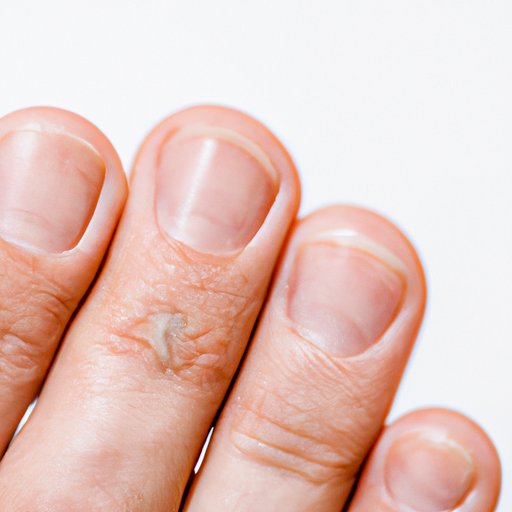Introduction
Your nails may seem like a minor detail when it comes to your health, but they can actually tell you a lot about your overall wellbeing. Paying attention to your nails can help you identify underlying health issues and take action before they become more serious. Knowing what to look for and how to recognize signs of infection, nutrient deficiency, or other health concerns can help you maintain healthy nails and protect your overall health.
Body
I. How Common Nail Problems Can Indicate Underlying Health Issues
Nail abnormalities can range from subtle changes in color or texture to more noticeable deformities. According to a 2011 study published in the Journal of Cutaneous and Aesthetic Surgery, “Nail changes are common, and many times signify an underlying disease process.”
Common types of nail abnormalities include:
- Discoloration (yellow, white, brown, or green)
- Thickening or thinning
- Brittleness/fragility
- Ridges or grooves
- Pitting
- Clubbing
- Separation of the nail from the nail bed
These abnormalities can indicate a wide range of underlying health issues, such as:
- Thyroid disorders
- Hormonal imbalances
- Diabetes
- Heart disease
- Liver disease
- Infections
- Nutrient deficiencies
- Autoimmune diseases
II. How to Recognize Signs of Infection, Nutrient Deficiency, or Other Health Concerns in Your Nails
Changes in color, texture, shape, and size can be signs of infection, nutrient deficiency, or other health concerns. Here are some of the most common symptoms to look out for:
A. Color Changes
Changes in nail color can be caused by various factors, including injury, fungal infections, or skin conditions. Yellow nails can be a sign of diabetes, while white nails can indicate liver disease. Green nails are usually caused by bacterial or fungal infections.
B. Texture Changes
Brittle or ridged nails can be caused by a lack of vitamins and minerals, such as zinc, calcium, and iron. Thickened nails can be a sign of fungal infections, while spoon-shaped nails can indicate anemia.
C. Shape and Size Changes
Unevenly shaped nails can be caused by an injury or a fungal infection. Clubbing, which is a widening and rounding of the fingertips, can indicate lung disease.
III. Tips for Maintaining Healthy Nails
Maintaining healthy nails is important for keeping your overall health in check. Here are some tips for keeping your nails healthy:
- Regularly trim and file them – Keeping your nails trimmed and filed can help prevent hangnails, ingrown nails, and other problems.
- Keep them clean – Wash your hands regularly and use a soft brush to scrub underneath your nails to remove dirt and bacteria.
- Wear gloves when doing household chores – Wearing gloves while doing dishes, gardening, or cleaning can protect your nails from harsh chemicals and detergents.
- Avoid harsh chemicals and detergents – Harsh chemicals can strip away the natural oils in your nails and make them brittle and prone to breakage.
- Eat a balanced diet – Eating a balanced diet that includes plenty of fruits, vegetables, and lean proteins can help keep your nails strong and healthy.
IV. What to Do if You Notice Changes in Your Nails
If you notice any changes in your nails, the first thing to do is not panic. While changes in your nails can indicate underlying health issues, they could also be caused by something as simple as an injury or an allergic reaction. It’s important to take note of any changes and to consult a healthcare professional if necessary.
V. A Survey of Nail Treatments Available to Maintain Healthy Nails
There are a variety of treatments available for maintaining healthy nails. Professional manicures can help keep your nails looking their best, while home remedies such as olive oil and lemon juice can help moisturize and strengthen your nails. In cases of infection or other health concerns, medication may be prescribed.
VI. The Importance of Consulting a Healthcare Professional About Any Changes in Your Nails
It’s important to consult a healthcare professional if you notice any changes in your nails. A doctor will be able to accurately diagnose the cause of the problem and provide the right course of treatment. According to Dr. Erin Gilbert, a board-certified dermatologist and founder of Entière Dermatology, “It’s essential to have an accurate diagnosis so you can receive the appropriate treatment.”
Conclusion
Your nails can tell you a lot about your overall health, so it’s important to pay attention to them and take action if you notice any changes. Maintaining healthy nails requires regular trimming and filing, keeping them clean, wearing gloves when necessary, avoiding harsh chemicals, and eating a balanced diet. If you do notice any changes, it’s important to consult a healthcare professional for an accurate diagnosis and the right course of treatment.
(Note: Is this article not meeting your expectations? Do you have knowledge or insights to share? Unlock new opportunities and expand your reach by joining our authors team. Click Registration to join us and share your expertise with our readers.)
